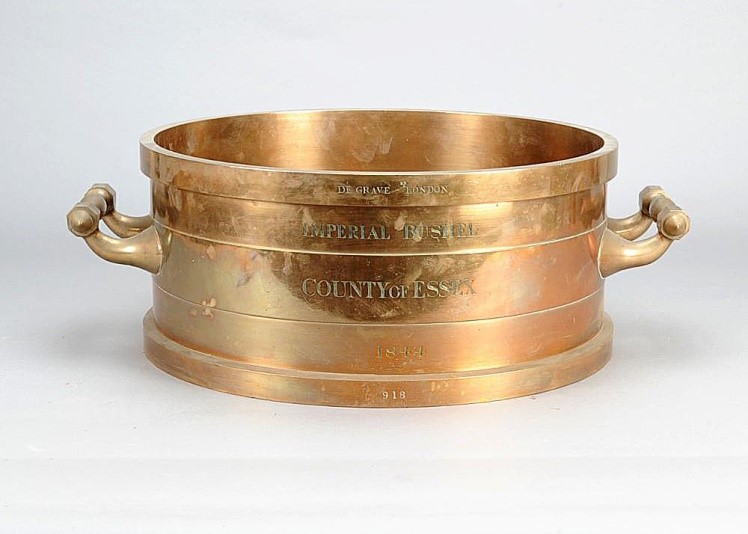THE MILL
Newsletter for Members and Friends of High Salvington Windmill October 2020
Restoration Decisions, by Jeff Best, Acting Chairman
 Posting pictures of the buck cladding repairs onto our Facebook page elicited a response from an enthusiast involved in repairing mills elsewhere. Why, he wanted to know, were we replacing with lengths of board shorter than the length of the buck, leading to end-on-end joins which might be more vulnerable to rot?
Posting pictures of the buck cladding repairs onto our Facebook page elicited a response from an enthusiast involved in repairing mills elsewhere. Why, he wanted to know, were we replacing with lengths of board shorter than the length of the buck, leading to end-on-end joins which might be more vulnerable to rot?
The challenge in restoration is to decide to what state you are restoring something. This is as true of windmills, pumps, engines and generators as it is for any other artefact in need of restoration. Should the end result be “as new”? Do you want it to be as it was when it was last used? Are you going to repair using the latest materials and techniques, to give it a new lease of life? At High Salvington the philosophy has always been to aim for the “last use” state, with limited adoption of newer materials and techniques where unavoidable, hence the use of Sadolin to replace tar on the buck and the latest material used to keep the roundhouse roof watertight, which is quite modern but visually in keeping with materials of yore.
Assuming this philosophy, I sought answers for our Facebook correspondent. If we had chosen to use larch cladding boards of this length then was there some evidence that this was the state of cladding when the mill was last in commercial use in 1897? I was soon put right by our veteran technical advisor, Peter Casebow. The 7” wide larch boards we use were originally as recommended by the members of the Weald and Downland Open Air Museum who sat on our Board in the early days of the restoration. This choice gives us a 55% overlap, so that we had two board coverage of the entire mill buck, and any abutting joints lay over a full board with soakers underneath. Working with boards, the length of the buck would also be a challenge, as the longer the board, the more prone it is to split. Our boards are “tanalised” before use, i.e. they are impregnated with the latest Tanalith wood preservative, using pressure and vacuum, so that it replaces water deep within the cells of the timber to protect it from insects, microbes and fungus. Our Facebook correspondent reported having to replace cladding that had rotted in less than ten years. According to Peter, the small number of boards we are replacing this year have been in place for nearly 36 years! Moreover, there is no evidence of any of the boards suffering from ends rotting.
All this reminds me that while our objective is the preservation of the windmill, and more recently the additional pumps, engine and generator, an important part of our responsibility at the Trust is to preserve the knowledge of designs, materials and techniques so that future generations can understand how and why choices were made to preserve also the tradition of the restoration. So, while the handy-skilled doers do vital repairs, we need documenters to document choices and our archivists need to ensure that all of this recorded knowledge is readily accessible to the next generation so that they may continue the good work long into the future!
ooOoo
Major Painting Project, by Ian Fairclough
 The painting of the mill by our contractor (Colin Brooker from Littlehampton) and the buck roof repairs carried out by volunteers have been completed and by the time you receive this newsletter, the scaffolding should have been removed, allowing the grand old lady to be displayed in all her glory. I’m sure autumn weather conditions will enable us to give her a quick spin too.
The painting of the mill by our contractor (Colin Brooker from Littlehampton) and the buck roof repairs carried out by volunteers have been completed and by the time you receive this newsletter, the scaffolding should have been removed, allowing the grand old lady to be displayed in all her glory. I’m sure autumn weather conditions will enable us to give her a quick spin too.
This is the first time the sails have been painted in situ which presented the scaffolders and the painter with some challenges as only one sail could be painted at a time with it in a perpendicular position. The scaffolding around the sail had to be dismantled and re-assembled for each sail but this process was managed well.
The Maintenance team have also been busy with their paintbrushes during the summer and all buildings and structures on site have or will have been freshened up with a coat of black (and white where appropriate!). This included re-caulking and the painting with tar of the Roundhouse walls. At the time of writing this update only the two metal wind engines require completion.
Site gardening has continued throughout so the whole mill site will make a very pretty picture once the scaffolding has gone. What a shame our visitors can’t come and enjoy it until next year (hopefully!!).
No peace for the wicked – the maintenance team are not sitting on their laurels as their attention has now turned to the installation of the hand pump acquired from a local resident’s garden. The pump will be sited outside of the small mills area so that children – young and old, can play with it. Work has started with a hole for the water tank (a dustbin!) being deftly dug by Ryan Flippance our local (very helpful) JCB driver. It is intended to have the pump installed and working before the end of the year.
ooOoo
Grain Measures, by Michael Steele
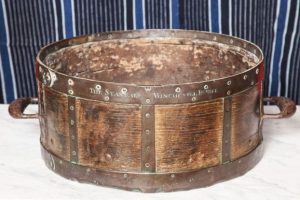
People didn’t trust the miller! He could “adjust” the measures of grain to his advantage. Theoretically, there was just one single corn measure in England although individual bushels were often damaged by age or falsified by accident or design. According to Magna Carta there would be uniform measures across the realm but this did not actually happen. In 1496 Henry VII set up the “Winchester” measures which were also never enforceable and parliament reported in 1758 that the standards were still far from fair and consistent. This led in due course to the Weights and Measures Act of 1824 when standards really were enforced and volume measures had to comply with a standard design of height and width.
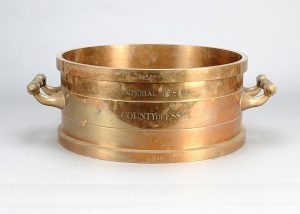
Our understanding of market prices is different today to what it was. Bread was sold by the loaf and whilst its price stayed the same, its weight went up or down according to the harvest or market conditions and the size was regulated by the authorities. Similarly, a bushel of grain had many different sizes yet all with the same name. Goods were sold by “custom and usage” at a “fair price” rather than by uniform weights and measures.
How (and why) France changed to metric
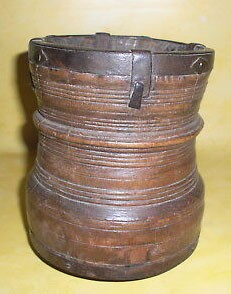
Let us consider the position in France before the Metric System when every town and village would have its own measures. There were some 250,000 different units of measure in France in the 1700s and a bushel (boisseau) of grain could be manipulated by the way in which it was filled. If the sack is tipped into the measure from rim height it is less compressed (i.e. of lesser weight) than if the sack is held at shoulder height – as could be enforced by the more powerful party to the transaction. The measure could be required to be heaped or level so as to influence the volume. A miller could ensure that machinery was running during the pouring so that the vibration shook the grains down and he received more grain than if it were done on a stable ground. The actual volume of the bushel could also be manipulated by it having to be heaped or level. Also, the heap is affected by its shape (the heap above a wide neck contains more grain than a heap above a narrow neck) and the strickle used to level the grain could be flat or cylindrical (a cylindrical one compresses grain into the measure). There could be an “allowance” for mice depredation or for drying out or even for a higher or lower quality of a particular harvest.
The bushel’s volume usually depended upon the type of grain being measured so that the same unit name applied to different quantities of wheat, barley or oats for example. There was a different volume for a bushel of small oats to that for large oats.
Most of the abuses were based on the individual power of the party who could insist on his measure being used and how. The peasant wanted as little grain as possible when he took it to the miller – who wanted as much as he could get from the peasant but give as little as he could to the wholesaler. The miller wanted to pay his corn rent to the land-owner with as little grain as he could get away with. The Church or land-owner wanted as much as their agent could force into the measure (and the agent could extract a percentage for himself often from the heap above the measure itself) but wanted it smaller when paying tax. It was common for the landowner to have two bushels – one for receiving corn rent and one for selling. The king wanted to ensure that his exchequer was getting the maximum extractable from the owners. If bulk grain was rafted down a river to a port, the wholesalers had the whip hand even over the landowners: they could decree their own measures as it was impracticable to ship the cargo back upstream again.
There was no effective independent check of standards and the size of the bushels even increased year to year as the landowner had larger measures made for corn rent purposes.
By 1789 there was a build-up of complaints calling for one standard measure for all throughout the country and the Metric System was finally introduced. People didn’t really get what they wanted though as in the market place it is more practical to count in units that are divisible into halves than by 10 and the new system was not immediately effective. For a number of decades the authorities allowed a total confusion of hybrid measures with old names but with new quantities or vice versa. Eventually the old measures were finally destroyed (there are few of the old measures left even in museums) and a system of standardised units finally came in as the scientific and industrial revolutions gathered momentum.
ooOoo
SPAB Wind report, by Jeff Best
The Society for the Protection of Ancient Buildings recently advertised a Webinar, “Wind and Windmills: Friend or Enemy?” and two members of the board attended. Steve Temple, SPAB Guardian and Mills Section committee member, addressed an issue of great interest to all windmills: how do we reliably establish the impact of proposed nearby developments?
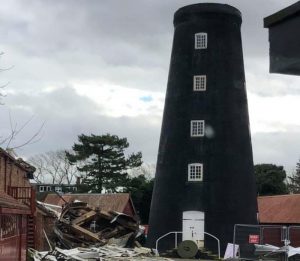
Steve provided two documents as homework, a Wind Report and a Storm Report. The Storm Report dealt with damage to mills during the recent storms Ciara and Dennis including Burgh Le Marsh which lost its cap and Soham Downfield which suffered a broken brake wheel. Furthermore, the storm-induced reversal of the sails had bent the short piece of RSJ used to sprag the wheel. We have neither a fantail nor a cap so the chance of our mill being adversely winded in a storm due to gusts against shutter sails is reduced. Our vigilant millers also rope the tail pole to reduce the risk of unwanted winding. We chock our brake wheel in both directions using stout lengths of wood which may very well be stronger than a short length of RSJ, eliminating the risk of sails reversing and then smashing back with force to break our brake wheel.
In his Wind Report Steve showed that with a few months’ anemometer measurements he could calculate, for ten degree intervals, the difference between on-site wind power and the nearest meteorological station’s decades of data and then transpose the data to produce a windmill “rose” for his mill. He used this to validate and calibrate the Molenbiotoop calculations used in the Netherlands.
Combining a calibrated Molenbiotoop with heights of trees and buildings, derived from Google Earth 3D, for each ten degree point around his mill he produced a “milling rose” showing the average yearly hours of suitable wind force for milling in each arc. For Impington, he calculated that the 166 milling days his grandfather once enjoyed have been reduced to 23 days. His method simplifies calculating the impact of proposed developments and with SPAB Mills Section being asked to address planning applications every other day, often with only a few days to respond, this is a vital tool.
I believe we need to acquire and fit an anemometer so that we can transpose wind records from our nearest meteorological station to supply this to SPAB when we are next faced with a planning application threatening the mill.
ooOoo
Wartime flour supplies

At the start of the war Britain was importing around 70% of its grain, but with the demands of war and the risk posed by U-Boats to imported supplies, the government sought ways to make limited grain supplies go further.
Thus, National Flour was introduced in 1942. Its extraction rate was around 85%, which was much higher that the white bread that was almost universally eaten before the war: a similar rate to today’s brown bread. Extraction rate refers to the amount of flour produced compared to grain – for example, at an extraction rate of 85% per 100kg of grain, 85kg of National Flour would be produced. White bread in comparison is more heavily milled and processed, with a rate of around 70%. In 1941, calcium fortification was also introduced as Rickets was found to be common amongst those joining the Women’s Land Army. Fortification of bread continues today in all bread aside from wholemeal.
Bread was never rationed during the war, but it would come under rationing from 1946 till 1948. Commercial white bread, however, was banned altogether on the 6th April 1942, and sliced white bread wouldn’t be reintroduced until 1950, with the National Loaf abolished six years later. The National Loaf was unpopular and was dubbed ‘Hitler’s Secret Weapon’. It apparently had an unappealing colour and texture, but was much less wasteful than the more popular white bread and saved on limited supplies, as well as being healthier. Furthermore – at least according to the Minister of Food at the time – it acted as an aphrodisiac!
In today’s health-conscious world, with a backlash against white bread, it is interesting to see the unpopularity of the introduction of what effectively was brown bread. Indeed, the National Loaf didn’t appear to have any lasting effect, and as soon as it was reintroduced people started buying white bread again. From the Mills Archive
ooOoo
Looking for the skills we need
In a bid to find skilled people to help to maintain the mill, we have sent out a mailing to companies and contractors with carpentry, joinery, engineering and general building skills. The letter asked for volunteers, inviting them to a virtual meeting on 18th October. The meeting needed to be online since we are currently unable to hold a physical meeting in the mill field. We will repeat this exercise – targeting large employers, but we may wait until we can have volunteers physically present.
No Carols this year but let’s support our hospices
As you all know, every year in December volunteers organise a bonfire and carol singing round the fire. We collect donations from residents and friends who support us each year. All the donations go to St. Barnabas and the Chestnut Tree House hospices. This year, although there will be no bonfire or carols, on Friday 18th December from 8 am to 1 pm and Sunday 20th December from 10 a.m. until 1 p.m. the gate house will be open to receive your donations. During the “lock down” the charities lost much of their funding. We are sure they would be pleased to accept our help. Thanks go to Betty Potts for organising this.
ooOoo
Annual membership subscriptions can be paid by cheque or by Standing Order, and can be upgraded to Life membership at any time. Members can enter open afternoons free of charge by showing their card at the gate. We currently have 204 members (ten honorary), and would love there to be more.
Any questions: Paul Minter on membership@highsalvingtonwindmilltrust.co.uk
Capt. Paul Minter, Membership
Follow us on Facebook. Just look for High Salvington Windmill and “like” our page to see news about the mill and the planned events throughout the year.
‘The Mill’ is edited by Lucy Brooks. 01903 691945
